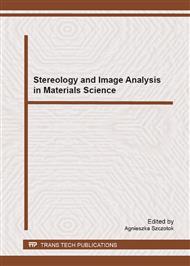p.198
p.203
p.209
p.215
p.221
p.226
p.232
p.238
p.244
Effect of Cooling Rate on the Porosity of the ZnAl22Cu3 Alloy
Abstract:
Zn-Al-Cu alloys are characterized by advantageous set of functional quality futures: tribological, strength, corrosion. They are used as an alternative material for bronze, cast iron and aluminum alloys in bearings and as a structural material. Properties of Zn-Al-Cu can be improved by partial or total replacement of copper with silicon and addition of rare - earth elements. Previous studies of the current authors have shown a significant effect of cooling rate on the structure of the ZnAl22Cu3 alloy. The presence of pores and significant differences in porosity between samples slowly and fast cooled has been found. The aim of this study was to determine the effect of cooling conditions on the pore formation in ZnAl22Cu3 alloy. The article presents the structure of the slowly and fast cooled alloy. Structural examinations were carried out on samples taken from the top, center and bottom of the ingot. In order to determine the microstructure metallographic tests were carried out using optical microscope and electron scanning microscope. Through EDS X-ray spectrometry quantitative analysis of characteristic microareas was performed as well. In order to assess the morphological characteristics of the pore a computer program Met-Ilo developed in the Department of Materials Science, Silesian University of Technology has been used. Changes of the volume fraction and the average area on a flat cross section in particular areas of the ingot were analyzed quantitatively.
Info:
Periodical:
Pages:
221-225
Citation:
Online since:
February 2013
Authors:
Keywords:
Price:
Сopyright:
© 2013 Trans Tech Publications Ltd. All Rights Reserved
Share:
Citation:


